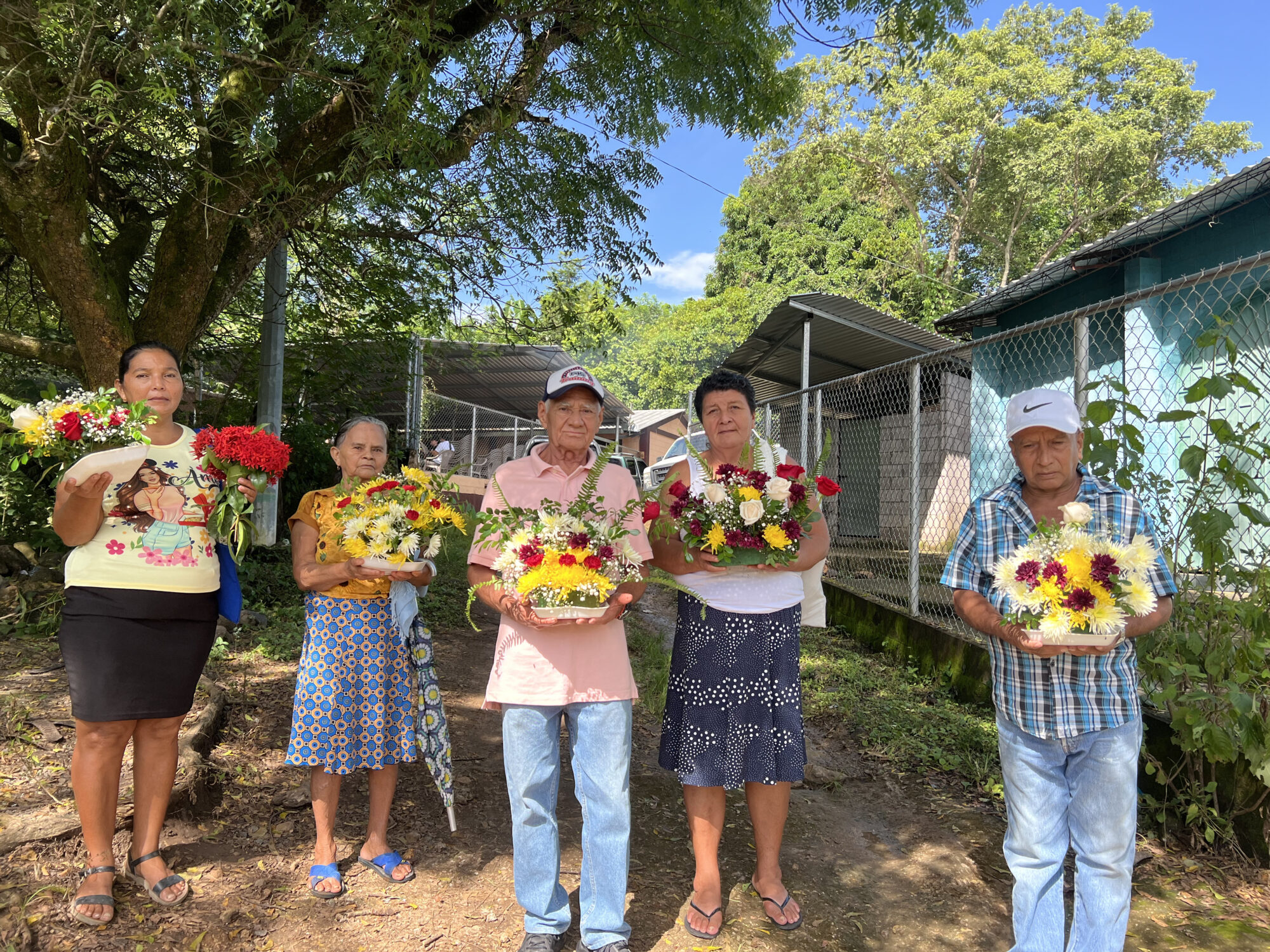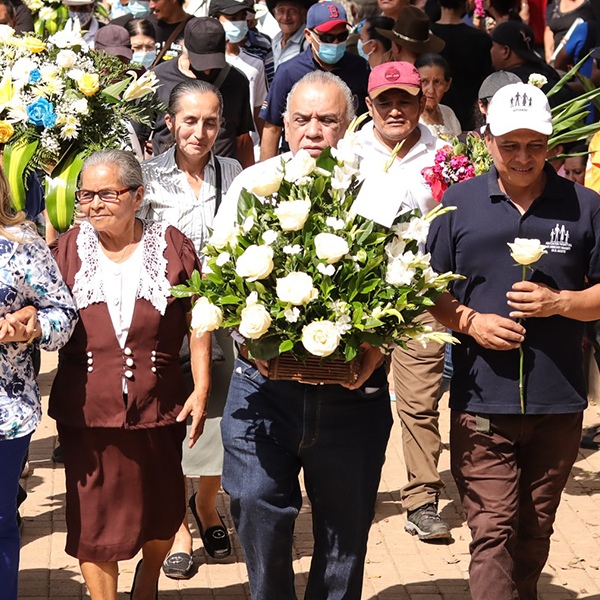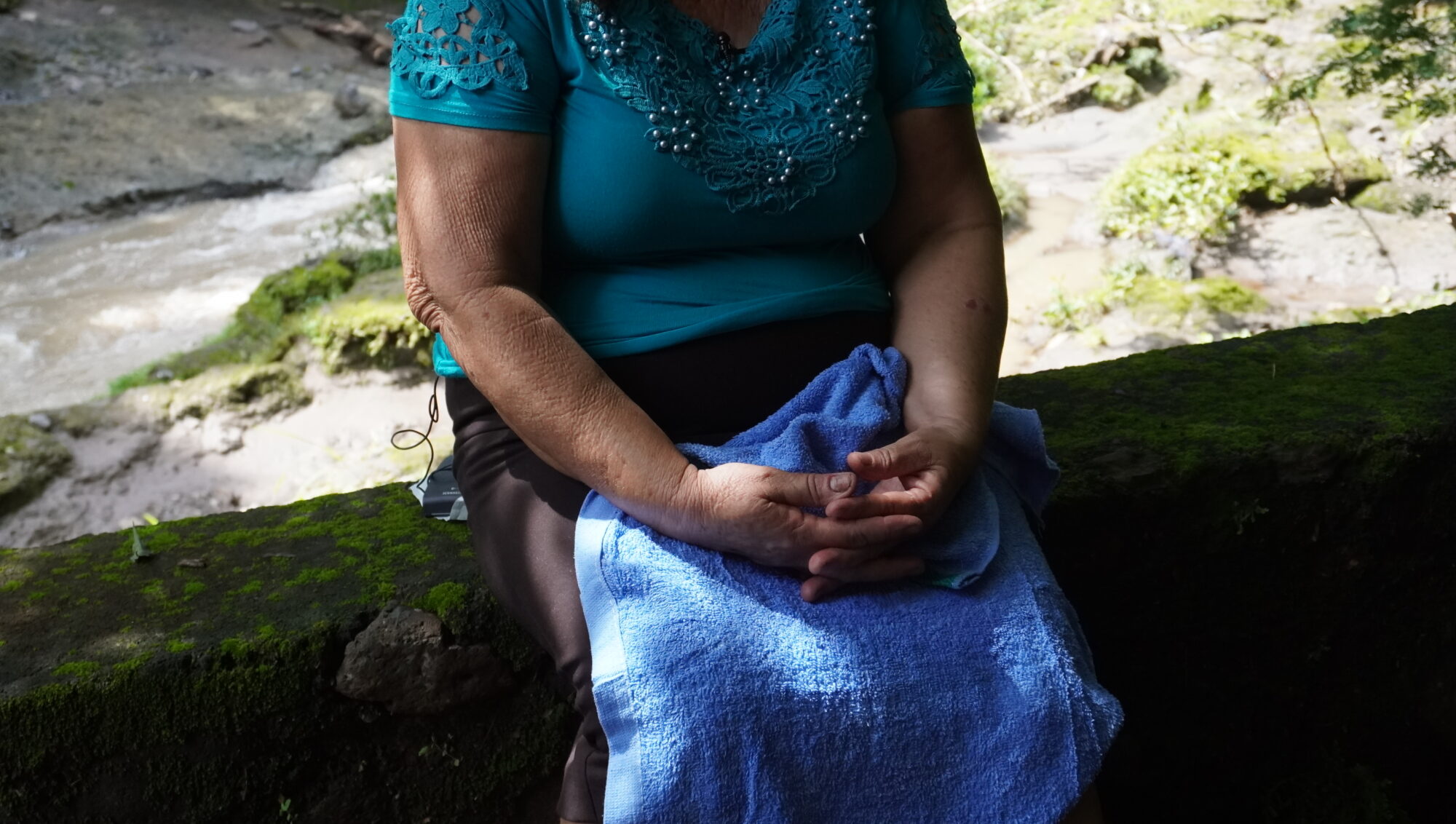
‘A People Who Has No Memory Has No Identity’ – Transitional Justice in El Salvador
It’s been 42 years, but Maria Lidia remembers that night like it was yesterday. “I could hear the screaming, that was the hardest part,” she says, inhaling, “I survived, but it was a miracle.”
On August 22, 1982, in the spot where we’re standing, Salvadoran armed forces from the Atlacatl Battalion shot and killed over 200 unarmed civilians – the majority of which were women, children, and the elderly. The massacre would later come to be known as “El Calabozo”.
“Long live our martyrs!” the crowd shouts over the light sounds of guitar. Today, like every year on the anniversary, the community has gathered to honor the memory of those slain in cold blood.
The memorial begins with a pilgrimage from the Amatitlán Arriba Community House to the Amatitlán Abajo River. The path is thick with mud in the aftermath of yesterday’s rainstorm, but it has not deterred the nearly one hundred people that came today. José Amado García, wanting to make sure as many people can attend as possible, lays down a fallen branch and extends a hand to help people across a slippery spot.
“Our loved ones, they were human beings and they cannot be forgotten … They [the government] want to erase the bloodshed that took place and it is not fair,” says Jose Amado. He explains that for decades, the Salvadoran government denied that the massacre ever occurred. “That’s why we need events like this,” he adds, “to remember”.
A lawyer with Cristosal’s transitional justice program, Irene Gomez, has also accompanied the event, sharing some words before the mass. “Historical memory is important so that we don’t repeat the same patterns of the past,” she says, “But we also need justice.”
El Salvador’s long road to justice
El Calabozo is one of several wartime cases that are part of ongoing endeavor for transitional justice in El Salvador. According to the OHCHR, transitional justice “covers the full range of processes and mechanisms associated with a society’s attempt to come to terms with a legacy of large-scale past conflict, repression, violations, and abuses.” Over forty years after systematic human rights violations committed during the internal armed conflict, survivors and victims are still fighting what in El Salvador has been an uphill battle.
“In order to understand transitional justice in El Salvador, you have to remember that there was a law that prohibited us from trying these cases until 2016,” says David Morales, Director of Cristosal’s transitional justice program.
In 1993–one year following the signing of the Peace Accords–the Legislative Assembly passed a blanket amnesty law that shielded perpetrators of human rights violations during the internal armed conflict from being prosecuted. In 2016, however, the law was overturned by the Supreme Court in a 4-1 ruling, stating that amnesty for crimes against humanity violated international law. Soon, victims could begin mounting these cases.
Cristosal joined the case of El Calabozo in 2017, working with the Center for the Promotion of Human Rights (CPDH) as one of the legal representatives of the victims in the criminal proceedings against six high-level military officers responsible for planning and carrying out the massacre. Movement on the case, however, has been stalled. No hearings have taken place since a series of exhumations around the river in 2018.

Further delays and obstacles
“I just want to see justice served in my lifetime,” says Jose Armando. He feels frustrated, saying that despite the current government’s apparent support for transitional justice, he and the other survivors feel abandoned with the failure to sentence those against those responsible.
Irene shares his frustration. “There is what we call a “double discourse”, where the government says that they’re supporting the victims, but they’re actually supporting the perpetrators of crimes against humanity,” she says, continuing, “At this moment, the judge still has not ordered the arrest warrants for the accused members of the military.”
This frustration is felt not only in El Calabozo, but across the country, by survivors and victims of human rights violations committed during the war. In El Mozote, members of the Committee for Human Rights of El Mozote explain the lack of movement on the case against the material and intellectual authors of the massacre that occurred in the same year as El Calabozo also by the Atlacatl Battalion.
“It’s an uphill battle, because the state still needs to come through on many things. We’ve always been here demanding for, more than anything, justice. But the process has been paralyzed for the last two years and we don’t know what’s going to happen,” says representative of the Association for the Promotion of Human Rights of El Mozote (APDHEM) Maria Eugenia Arguete.
Four hours north, almost at the border of Honduras, stands the town of El Mozote and site of the largest massacre in recent Latin American history. On December 6, 1981, members of the Atlacatl Battalion slaughtered nearly 1,000 civilians. In the central square stands a memorial, similar to that of El Calabozo, which lists the names and ages of all of the victims on a series of plaques lined against a wall. About half of the plaques list the names of children.
When the case reopened in 2017, Cristosal became the primary legal representative of the families of the victims, like Maria Eugenia. In the last few years, however, the case has faced some serious obstacles.
In 2021, Judge Jorge Guzmán, who had been overseeing the case, was forced to resign after President Bukele issued a decree to change the mandatory retirement age of judges to 60. As of 2024, no new hearings have been held.
Maria Eugenia says that while President Bukele claims to support justice, after all these years his actions say something else, instead they have set back progress and trivialize the experience of the victims. At the massacre site, the Salvadoran government facilitated changes to the area, constructing a memorial wall in the yard behind the church and a fountain in the central square.
“We’re looking at the fountain right now, but for us it hasn’t helped us in any way. For us, this place here is sacred, but the government wants to make it a place for tourism,” says Maria Eugenia.
Like Jose Armando, Maria fears she will not live to see a guilty verdict…


History repeating itself
“Transitional justice is about collective healing,” says Irene. “Obviously we want the victims of crimes to see justice served in their lifetimes, but it goes beyond that. Without justice, there is no way to ensure that these crimes won’t be repeated again,” she adds.
As one of the younger lawyers on the team, Irene forms part of a new era for transitional justice as youth join in the fight for accountability for El Salvador’s past crimes. “For me, it’s another honor and privilege to work with the victims of the internal armed conflict,” she says. She emphasizes the importance of involving young people in this work, especially as she sees patterns of repression against civilians being repeated under the state of exception.
“Repression against civilians, which we’re now seeing being committed by the police, was a crucial element in the behavior of the state during the armed conflict,”she says, continuing, “This is what we’re seeing with the state of exception. State forces are carrying out forced displacement, sexual violence, and torture.”
In Cristosal’s report on the second year of the state of exception, we found patterns of serious human rights violations being committed by the state which has resulted in over 80,000 people detained and 265 deaths within state custody.
“For years we said that if we don’t have justice for the past, we will have more violations in the future,” says David, “Now we’re seeing that play out before us.”
David, however, feels hope, especially as more young people join the human rights movement, calling for justice for the past and denouncing violations happening now. “It’s young people that will carry on this fight.”
In fact, young people played a major role in organizing the memorial today. Alfonso Ramirez is one of the guitarists, who worked with a youth committee to organize logistics for the event. “I was not there [at the massacre] but I heard the story from the elders and am involved in making sure other generations know about what happened,” he says, continuing, “A people who has no memory has no identity.”
Maria Lidia takes her seat next to Alfonso as he stops strumming his guitar. With a final hush, a young activist takes the microphone and begins to speak. Maria Lidia exhales and closes her eyes, listening.

